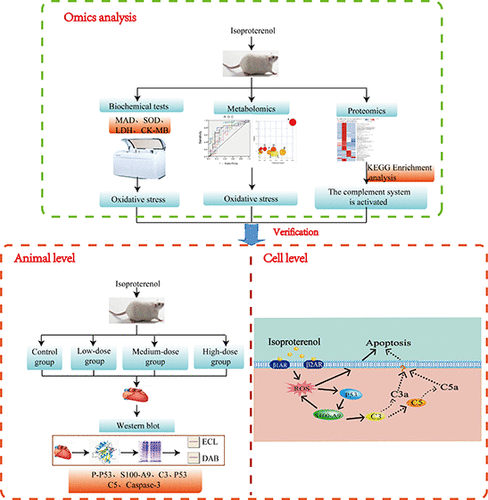当前位置:
X-MOL 学术
›
Chem. Res. Toxicol.
›
论文详情
Our official English website, www.x-mol.net, welcomes your feedback! (Note: you will need to create a separate account there.)
Isoproterenol triggers ROS/P53/S100-A9 positive feedback to aggravate myocardial damage associated with complement activation.
Chemical Research in Toxicology ( IF 4.1 ) Pub Date : 2020-09-14 , DOI: 10.1021/acs.chemrestox.0c00308 Simiao Fan 1 , Huan Zhao 1 , Yuechen Liu 1 , Pengjie Zhang 1 , Yuming Wang 1 , Yanyan Xu 1 , Kun Gu 1 , Tianpu Zhang 1 , Jiao Yu 2 , Wulin Qi 2 , Yubo Li 1 , Yanjun Zhang 1
Chemical Research in Toxicology ( IF 4.1 ) Pub Date : 2020-09-14 , DOI: 10.1021/acs.chemrestox.0c00308 Simiao Fan 1 , Huan Zhao 1 , Yuechen Liu 1 , Pengjie Zhang 1 , Yuming Wang 1 , Yanyan Xu 1 , Kun Gu 1 , Tianpu Zhang 1 , Jiao Yu 2 , Wulin Qi 2 , Yubo Li 1 , Yanjun Zhang 1
Affiliation

|
Negative feelings caused by external stress can continually agonize adrenergic receptors via promoting catecholamine secretion, causing cardiovascular disease. This study examines the mechanism by which persistent β-adrenergic receptor agonism induces myocardial injury. A rat model of cardiac injury was herein established using isoproterenol (5 mg/kg, continuous intraperitoneal injection for 3 days), and multiomics technology combined with metabolomics and proteomics was used to explore the mechanism by which persistent β-adrenergic receptor agonism induces myocardial injury. The mechanism underlying this phenomenon was further verified at the cellular level. Isoproterenol-induced persistent β-adrenergic receptor agonism promoted the release of reactive oxygen species, and P53, S100-A9, and complement 3 were shown to be involved in complement system activation pathways. Our data have demonstrated that isoproterenol could trigger ROS/P53/S100-A9 positive feedback to aggravate myocardial damage associated with complement activation.
中文翻译:

异丙肾上腺素触发 ROS/P53/S100-A9 正反馈以加重与补体激活相关的心肌损伤。
外部压力引起的负面情绪会通过促进儿茶酚胺的分泌不断刺激肾上腺素受体,导致心血管疾病。本研究探讨了持续的 β-肾上腺素能受体激动诱导心肌损伤的机制。本文采用异丙肾上腺素(5 mg/kg,连续腹腔注射3 d)建立大鼠心脏损伤模型,并采用多组学技术结合代谢组学和蛋白质组学研究持续性β-肾上腺素能受体激动诱导心肌损伤的机制。 . 这种现象背后的机制在细胞水平上得到了进一步验证。异丙肾上腺素诱导的持续性 β-肾上腺素能受体激动促进了活性氧的释放,P53、S100-A9、和补体 3 显示参与补体系统激活途径。我们的数据表明,异丙肾上腺素可以触发 ROS/P53/S100-A9 正反馈以加重与补体激活相关的心肌损伤。
更新日期:2020-10-21
中文翻译:

异丙肾上腺素触发 ROS/P53/S100-A9 正反馈以加重与补体激活相关的心肌损伤。
外部压力引起的负面情绪会通过促进儿茶酚胺的分泌不断刺激肾上腺素受体,导致心血管疾病。本研究探讨了持续的 β-肾上腺素能受体激动诱导心肌损伤的机制。本文采用异丙肾上腺素(5 mg/kg,连续腹腔注射3 d)建立大鼠心脏损伤模型,并采用多组学技术结合代谢组学和蛋白质组学研究持续性β-肾上腺素能受体激动诱导心肌损伤的机制。 . 这种现象背后的机制在细胞水平上得到了进一步验证。异丙肾上腺素诱导的持续性 β-肾上腺素能受体激动促进了活性氧的释放,P53、S100-A9、和补体 3 显示参与补体系统激活途径。我们的数据表明,异丙肾上腺素可以触发 ROS/P53/S100-A9 正反馈以加重与补体激活相关的心肌损伤。


























 京公网安备 11010802027423号
京公网安备 11010802027423号